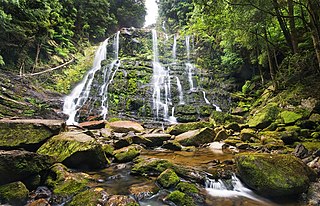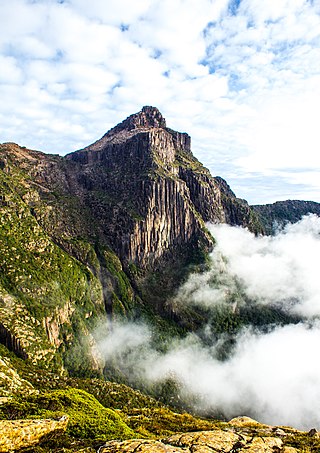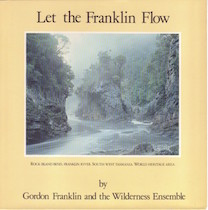
Tasmania is an island state of Australia. It is located 240 kilometres to the south of the Australian mainland, and is separated from it by the Bass Strait. The state encompasses the main island of Tasmania, the 26th-largest island in the world, and the surrounding 1000 islands. It is Australia's smallest and least populous state, with 573,479 residents as of June 2023. The state capital and largest city is Hobart, with around 40% of the population living in the Greater Hobart area. Tasmania is the most decentralised state in Australia, with the lowest proportion of its residents living within its capital city.

Franklin-Gordon Wild Rivers is a national park in Tasmania, 117 km west of Hobart. It is named after the two main river systems lying within the bounds of the park - the Franklin River and the Gordon River.

Lake Pedder, once a glacial outwash lake, is a man-made impoundment and diversion lake located in the southwest of Tasmania, Australia. In addition to its natural catchment from the Frankland Range, the lake is formed by the 1972 damming of the Serpentine and Huon rivers by the Hydro-Electric Commission for the purpose of hydroelectric power generation. Consequently, the lake is also known, somewhat derisively, as the Huon-Serpentine Impoundment.

The Gordon-below-Franklin Dam project was a proposed dam on the Gordon River in Tasmania, Australia, that was never constructed. The movement that eventually led to the project's cancellation became one of the most significant environmental campaigns in Australian history.

Lake Gordon is a man-made reservoir created by the Gordon Dam, located on the upper reaches of the Gordon River in the south-west region of Tasmania, Australia.

The Gordon River is a major perennial river located in the central highlands, south-west, and western regions of Tasmania, Australia.

Peter Dombrovskis was an Australian photographer, known for his Tasmanian scenes. In 2003, he was posthumously inducted into the International Photography Hall of Fame, the first Australian photographer to achieve that honour.

HuonvilleHYOO-on-vil is a town located on the banks of the Huon River in the Huon Valley, in the south-east of Tasmania, Australia. It serves as the administrative centre of the Huon Valley Council and is the largest town in the Huon Valley region. Situated approximately 38 kilometres south of the state capital, Hobart, Huonville acts as a gateway to Tasmania’s wilderness areas and the Southwest National Park.

Hydro Tasmania, known for most of its history as the Hydro-Electric Commission (HEC) or simply The Hydro, is the trading name of the Hydro-Electric Corporation, a Tasmanian Government business enterprise which is the main electricity generator in the state of Tasmania, Australia. The Hydro was originally oriented towards hydro-electricity, due to Tasmania's dramatic topography and relatively high rainfall in the central and western parts of the state. Today, Hydro Tasmania operates thirty hydro-electric and one gas power station, and is a joint owner in three wind farms.
Olegas Truchanas was a Lithuanian-Australian conservationist and nature photographer.

The Wilderness Society is an Australian, community-based, not-for-profit non-governmental environmental advocacy organisation.

Commonwealth v Tasmania was a significant Australian court case, decided in the High Court of Australia on 1 July 1983. The case was a landmark decision in Australian constitutional law, and was a significant moment in the history of conservation in Australia. The case centred on the proposed construction of a hydro-electric dam on the Gordon River in Tasmania, which was supported by the Tasmanian government, but opposed by the Australian federal government and environmental groups.

South West Tasmania is a region in Tasmania that has evoked curiosity and wonder during the period of European presence on the island.
Howard Clinton Zahniser was an American environmental activist. From 1945 until his death he led The Wilderness Society as executive secretary, executive director, and editor of The Living Wilderness. Zahniser was the primary author of the Wilderness Act passed by Congress in 1964.
The Gordon River Road, sometimes called the Strathgordon Road, (B61), is a road in the south western region of Tasmania, Australia.
The Tasmanian power referendum was a one-question referendum held on 12 December 1981, and intended to determine the location of a proposed hydroelectricity dam to be built on the Gordon River in Tasmania, Australia.

Beginning as a conservation movement, the environmental movement in Australia was the first in the world to become a political movement. Australia is home to United Tasmania Group, the world's first green party.
Kutikina Cave is a rock shelter located on the Franklin River in the South West Wilderness, a World Heritage Area in the Australian state of Tasmania.
Helen Gee was an Australian author, editor, conservationist and environmental activist.

"Let the Franklin Flow" is a song written by Shane Howard and recorded by Australian band Goanna. The song was released in April 1983 as a protest song to save the Franklin River from being dammed in Tasmania, Australia. "Let the Franklin Flow" peaked at number 12 on the Australian Kent Music Report.












